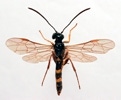July 6, 2010

Wheat stem sawfly populations are reported to be high again parts of the Dakota.
But NDSU entomologists say it will be a waste of time and money to spray them.
In 2009, NDSU researchers conducted large plot (25 acre) insecticide trail near Mott, N.D. They sprayed wheat three times with a pyrethroid for adult sawfly control.
"We found that three applications of a pyrethroid insecticide timed for the beginning, peak and end of sawfly flight reduced infested stems by half compared with the untreated check. However, the yield gain was not significant and only a 3.3 bushels per acre in the insecticide-treated plot versus the untreated check." says Janet Knodel, NDSU Extension entomologist.. "The estimated cost of the insecticides was $30 per acre (or $10 per acre per insecticide application). If wheat is valued at $5 per bushel, the gross revenue increase due to yield is $16.50 per acre. This results in a net loss of $13.50 per acre ($16.50 minus $30), in spite of the three applications of insecticides!"
NDSU Extension Entomology also compared several insecticides and spray timings for control of wheat stem sawfly at Hettinger and Makoti, N.D., in 2009.
The evaluated: 1) untreated check, 2) foliar insecticide at the 4-6 leaf stage, 3) foliar insecticide at flag leaf stage, 4) low rate of insecticide seed treatment, 5) high rate of insecticide seed treatment, and 6) low rate of insecticide seed treatment + foliar spray at the 4-6 leaf stage.
Cruiser 5FS was used as the insecticide seed treatment and Warrior II (pyrethroid) was used for all foliar insecticide applications. All seed treatments were applied commercially.
For percent infested stems, all of the insecticide treatments were comparable except that the low and high rate of Cruiser had a significantly higher percent infested stems than the low rate of Cruiser + Warrior II at the 4-6 leaf stage.
Infested stems of the insecticide treatments were not different from the untreated check. As expected, there were no significant yield differences among the different insecticide treatments or between insecticide treatments and the untreated check. The untreated check had the lowest yield, which was probably due to root rot diseases because no fungicide seed treatment was used (bare seed).
Insecticides generally have not been effective against the wheat stem sawfly. The egg, larval and pupal stages are well-protected inside the plant stem. Spraying for adults has not been successful because newly emerged adults can migrate into a field that was sprayed, the sawfly emergence window is so long and adults that emerge after spraying have reduced exposure to insecticide. The adult has no mouthparts and does not feed or drink water, which minimizes exposure to insecticides.
Source: NDSU Extension Crop and Pest Report
You May Also Like




